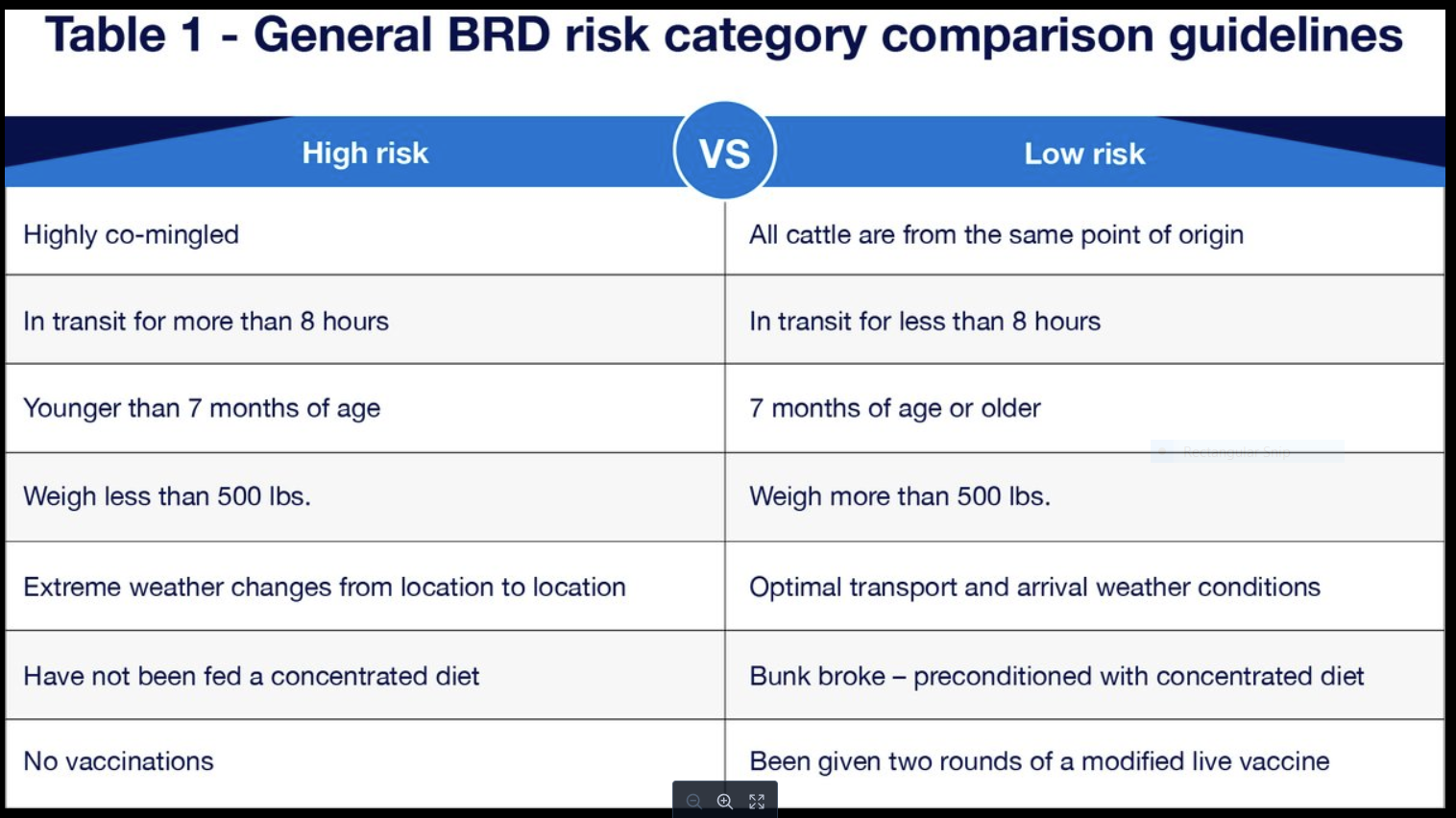Categorizing Feedlot Cattle for better BRD Management

This article was developed by Ronald K. Tessman, DVM, Ph.D., DACVIM, DACVPM, Technical Consultant – Beef, Elanco Animal Health
Preventing and managing bovine respiratory disease (BRD) is an ongoing challenge for beef cattle, especially for stocker and feedlot operations, as well as for dairy youngstock. Categorizing cattle for BRD risk level upon arrival at the stocker or feedlot facility can be a helpful management tool to minimize the health and economic impacts of BRD on an operation, especially when the cattle industry faces other challenges that can increase risk such as the current nationwide drought.
BRD predictive factors
BRD predictive factors or risk factors along with a visual assessment of the animals are tools used to subjectively estimate the BRD risk for a group of cattle.1 The animal’s characteristics and transient influences are predictive factors that should be considered when categorizing cattle for BRD risk. Animal characteristics can include their age, weight, weaning status, origin, nutrition status and preconditioning history. Transient factors include weather, transit conditions and length of haul. While these factors are relatively fixed, cattle producers face a few challenges that can further influence a feedlot operation’s BRD risk level.
Industry challenges and BRD
Cattle producers across the country have experienced some level of drought this year and for some, several years. These conditions severely affect cow-calf producers due to the decreased forage production, which diminishes pastureland for grazing. This forces producers to make hard management decisions, which can affect stocker and feedlot operations and ultimately their BRD risk.
Weather conditions have always played a significant role in an operation's risk for BRD. However, drought can have a longer lasting negative impact because it restricts some normal management practices like preconditioning by weaning, vaccinating and bunk breaking. In drought conditions, cow-calf producers are often forced to wean calves in transport due to the short supply of forages and increased input costs, restricting the ability to efficiently supplement with feeds to meet nutritional requirements. Therefore, these young calves haven’t had time to develop an immune system and rumen ready for the feedlot.
This creates additional management stressors on these younger calves to appropriately acclimate them to the feedlot, which puts them at a higher risk for BRD. This can also pose a bigger health and economic threat for the cattle feeder, as these calves will likely need to stay on feed longer.
Determining BRD risk categories
The process of classifying BRD risk is not a one-size-fits-all approach. Cattle are often classified into high or low risk categories using a consistent set of predictive factors. However, some producers may find it beneficial to have additional categories based on their individualized classification process. In addition to the assessment of known factors like travel length and purchase weight, producers should perform a visual inspection of the cattle groups once they arrive and while they are acclimating to their new environment to help with risk placement.
Table 1 is a general guideline for assigning cattle to a BRD risk category based on the major predictive factors known to increase or decrease BRD risk.
Age and weight have been correlated historically with young, lightweight calves being considered high risk for a number of reasons. However, with today’s improved genetics and production strategies, our prior perception of weight/age correlation may not necessarily be an accurate indication of age. Therefore, we should not assume a 500+ lb. calf is 7+ months old and automatically place them in the low-risk category. The calf may be heavier, which certainly helps lower BRD risk, but developmentally, they are still less than 7 months old. They have had a shorter time from weaning, which likely means little to no acclimation to concentrated feeds. Their immune system has had less time to develop, and it is likely they haven’t had their vaccines to add a layer of protection for the developing immune system. All of which would put them at higher risk. So, it is important to consider the age of the animal as a separate variable from arrival weight when placing them in a risk category.
Some producers will find certain predictive factors do not apply to their operation or are less significant, while others will rely heavily on a particular predictive factor. It is essential producers determine the factors that are important to their operation and apply them consistently year after year to categorize cattle. Consistently using the same predictive factors, combined with a visual assessment of each cattle group will help producers more accurately assess their BRD risk and develop a plan for efficient and effective mitigation efforts.
Preventing BRD can be difficult. That’s why categorizing cattle groups upon arrival continues to be an effective tool to help manage BRD, mitigate future outbreaks and ultimately protect your investment.
Reference:
1 Nickell, J., White, B. Metaphylactic antimicrobial therapy for bovine respiratory disease in stocker and feedlot cattle. National Library of Medicine. 2010.








